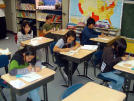NJ Students Score Better Than Average
 Governor James E. McGreevey and Commissioner of Education William L. Librera today announced that New Jersey students scored higher on average than students across the nation in fourth- and eighth-grade math and reading tests, according to National Assessment of Educational Progress (NAEP) results, released by the National Center for Educational Statistics (NCES).
Governor James E. McGreevey and Commissioner of Education William L. Librera today announced that New Jersey students scored higher on average than students across the nation in fourth- and eighth-grade math and reading tests, according to National Assessment of Educational Progress (NAEP) results, released by the National Center for Educational Statistics (NCES). Additionally, New Jersey students achieved the third-highest average scale score in fourth-grade reading (225) and fifth-highest scale score in fourth-grade math (239) in the nation, according to the NAEP results, released this morning.
“These test results show that we are headed in the right direction with our continued focus on early literacy, high standards, and high quality teaching,” McGreevey said. “While New Jersey's scores place us among the highest performing states in the nation, there is still more work to be done. We will not be satisfied until all of our children are proficient and we have closed the achievement gap.”
“We have said time and time again that New Jersey’s students and teachers are among the best in the nation,” Librera said. “Today’s report further emphasizes that this is true. We continue to stress the importance of reading at grade level by the third grade. We are confident we are creating a foundation for better learners for generations to come.”
The key elements in the NAEP report
· New Jersey’s average scale score for fourth-grade reading was 225. While not deemed statistically significant, only Connecticut (228), Massachusetts (228), New Hampshire (228) and Vermont (226) scored higher.
· New Jersey students had an average scale score of 239 for fourth-grade math. Only New Hampshire (243), Minnesota (242), North Carolina (242) and Vermont (242) were deemed statistically significantly higher than New Jersey. Kansas (242), Massachusetts (242), Connecticut (241) and Wyoming (241) were placed in the same statistical category as New Jersey. Virginia also had an average scale score of 239.
Additionally, since the implementation of the Core Curriculum Content Standards in 1996, New Jersey children performed better in mathematics at both the fourth- and eighth-grade levels than students assessed prior to 1996. Similarly, fourth-grade children statewide have demonstrated a significant growth in reading when compared to those a decade ago.
Known as “The Nation’s Report Card,” the NAEP study is the only nationally representative, continuing assessment of what the nation’s students know and can do in various subject areas. NAEP provides a comprehensive measure of students’ learning at critical junctures in their school experience.
“With continued emphasis on early childhood literacy, the Department of Education (DOE) and the McGreevey Administration expect to see such encouraging results continued in the near future,” Commissioner of Education William L. Librera said. “This year’s NAEP results show us that our children are improving, achieving and succeeding. We are encouraged by the continued progress we see in our classrooms.”
In New Jersey, students’ average scale scores were higher across the board than the average for the nation’s public schools in each of the four NAEP categories:
· Fourth-grade reading: NJ- 225, US- 216;
· Fourth-grade math: NJ- 239, US- 234;
· Eighth-grade reading: NJ- 268, US- 261; and
· Eighth-grade math: NJ- 281, US- 276.
Commissioner Librera said NAEP results should not be confused with the reporting requirements of the federal No Child Left Behind Act (NCLB), which identifies schools in need of improvement based on fourth- and eighth-grade state assessments in Language Arts/Literacy and Math.
In discussing the differences between the NCLB process and the significance of the NAEP results, Commissioner Librera said there is a fundamental flaw in the implementation of NCLB since New Jersey has a high number of schools on the needs improvement list as required by the federal education act, yet the federal NAEP results indicate the state is succeeding.
“These results tell us what we’ve said all along about the implementation of NCLB,” Commissioner Librera said. “We believe it is unfair to label many of the fine schools throughout this state as in need of improvement when clearly, our students are showing progress. This is clearly evident in the NAEP report.”
With the advent of the federal No Child Left Behind (NCLB) Act, school districts who submit state applications for Title I funds are required to participate in all aspects of NAEP. Failure to comply could result in a loss of Title I funding.
Encouraging signs in New Jersey from the NAEP report include: an increased percentage of students who performed at or above proficient in fourth-grade reading (39 percent this year, 33 in 1994); and a greater percentage of students who performed at or above proficient in fourth-grade math (39 percent this year, 25 percent in 1996).
Commissioner Librera said the DOE is also encouraged that the gaps between Hispanic students and white students in fourth-grade math lowered from 32 points in 1992 to 24 this year. In 2003, the average scale score for whites in fourth-grade math was 248. For Hispanic students, the average scale score was 224. The scores in 1992 were 233 and 195, respectively.
Fourth-grade reading scores demonstrate a similar trend. According to NAEP, white students scored 23 points higher than Hispanic students in 2003 (235 versus 212, respectively), which is 15 points lower than in 1992 (a 38-point difference, with scores of 233 and 195, respectively).
Similar results are found between black students and white students, according to fourth-grade math results — a 31-point difference this year, whereas the difference was 38 points in 1992. Additionally, the percentage of black students increased significantly at the basic level, compared to 1992.
“We continue to work with school districts to address the needs of all students — especially in our Abbott districts and others where we have high concentrations of poverty, while at the same time, diversity,” Commissioner Librera said. “Through early childhood programs and continued emphasis on sharing best practices and strategies, we remain optimistic that all of our children throughout the state will succeed when given the chance.”
Since 1969, NAEP assessments have been conducted periodically in reading, mathematics, science, writing, U.S. history, civics, geography, and the arts. New Jersey has participated voluntarily in the study since 1992. This is the first year that all Title I eligible schools participated in the program in New Jersey.
NAEP does not provide scores for individual students or schools; instead, it offers results regarding subject-matter achievement, instructional experiences, and school environment for populations of students (e.g., fourth-graders) and subgroups of those populations (e.g., female students, Hispanic students), according to the organization’s Web site. NAEP results are based on a sample of student populations of interest.
For more information about NAEP, please visit the NCES Website. For additional questions, please contact the Department of Education Public Information Office at (609) 292-1126.
advertisement

Author: Press Release - State of New Jersey
Archives
A TALE OF THREE WEDDINGS
Timber Creek’s Leary heads to Illinois
The Berlin Cemetery
A Southern Mansion
Fire on the Morro Castle
Pine Barrens Fire of 1936
The Legacy of Hezekiah Bradley Smith
The Powhatan Renape Indians
The `Park-In` Movie Theatre
Glassboro: A History
New Jersey Natives: The Lenni-Lenape
Burlington County Prison Museum
Parvin State Park
Haines Mill
John Henry `Pop` Lloyd
More...







